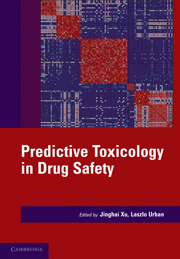Book contents
- Frontmatter
- Contents
- Contributors
- Prologue – Predictive toxicology: a new chapter in drug safety evaluation
- PREDICTIVE TOXICOLOGY IN DRUG SAFETY
- I SPECIFIC AREAS OF PREDICTIVE TOXICOLOGY
- II INTEGRATED APPROACHES OF PREDICTIVE TOXICOLOGY
- 10 Integrated approaches to lead optimization: improving the therapeutic index
- 11 Predictive toxicology approaches for small molecule oncology drugs
- 12 Mechanism-based toxicity studies for drug development
- 13 Fish embryos as alternative models for drug safety evaluation
- 14 The role of genetically modified mouse models in predictive toxicology
- 15 Toxicogenomic and pathway analysis
- 16 Drug safety biomarkers
- 17 Application of TK/PD modeling in predicting dose-limiting toxicity
- 18 Prediction of therapeutic index of antibody-based therapeutics: mathematical modeling approaches
- 19 Vaccine toxicology: nonclinical predictive strategies
- Epilogue
- Index
- Plate section
- References
13 - Fish embryos as alternative models for drug safety evaluation
from II - INTEGRATED APPROACHES OF PREDICTIVE TOXICOLOGY
Published online by Cambridge University Press: 06 December 2010
- Frontmatter
- Contents
- Contributors
- Prologue – Predictive toxicology: a new chapter in drug safety evaluation
- PREDICTIVE TOXICOLOGY IN DRUG SAFETY
- I SPECIFIC AREAS OF PREDICTIVE TOXICOLOGY
- II INTEGRATED APPROACHES OF PREDICTIVE TOXICOLOGY
- 10 Integrated approaches to lead optimization: improving the therapeutic index
- 11 Predictive toxicology approaches for small molecule oncology drugs
- 12 Mechanism-based toxicity studies for drug development
- 13 Fish embryos as alternative models for drug safety evaluation
- 14 The role of genetically modified mouse models in predictive toxicology
- 15 Toxicogenomic and pathway analysis
- 16 Drug safety biomarkers
- 17 Application of TK/PD modeling in predicting dose-limiting toxicity
- 18 Prediction of therapeutic index of antibody-based therapeutics: mathematical modeling approaches
- 19 Vaccine toxicology: nonclinical predictive strategies
- Epilogue
- Index
- Plate section
- References
Summary
INTRODUCTION
Approval of new medicinal products requires demonstration of their efficacy and safety. Therefore, development of new drugs is processed in distinct phases including basic research, lead discovery/development, preclinical testing, and final clinical trials. Drug safety is initially evaluated preclinically in laboratory animals (rodents and other mammals). Preclinical safety data are then submitted to appropriate authorities such as the U.S. Food and Drug Administration (FDA) or the European Medicines Agency (EMEA) for the approval of subsequent clinical trials in human subjects. Clinical trials are performed in three phases in human patients with increasing number of volunteers starting with 20 to 80 healthy volunteers in phase I and ending with about 200 to 2,000 people in phase III to demonstrate that the drug offers significant clinical benefit. In these studies only part of the patients receive the new drug, the remainder are treated with a placebo or comparator.
Due to the thorough preclinical and clinical trial phases development of new drugs has become a lengthy (10–15 years) and expensive process. From the early identification of lead compounds to preclinical and clinical trials expenditures of $0.5 to 2 billion are estimated (see References 3, 4, 5, and references therein). Although the actual cost estimates for new drugs may be inflated in some calculations and only valid for compounds with new molecular entities, all estimates demonstrate the enormous investments associated with the development of a new drug.
- Type
- Chapter
- Information
- Predictive Toxicology in Drug Safety , pp. 244 - 268Publisher: Cambridge University PressPrint publication year: 2010



